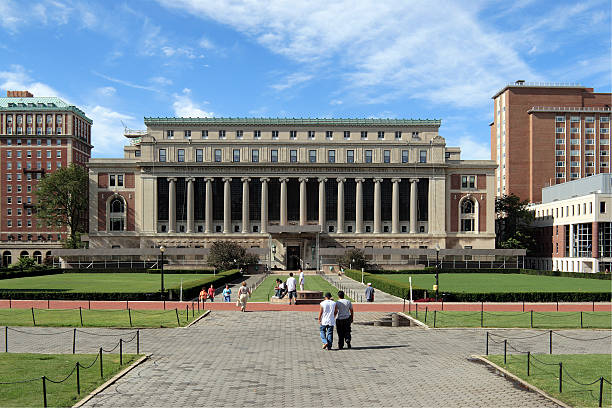With a significant percentage of undergrad students opting to transfer during their college education, moving from one undergraduate program to another is easier than you might think.
So, if attending Columbia has always been your goal or if you’re simply interested in the transfer process in the United States, you should understand the details of Columbia’s transfer acceptance rate.
Just because you didn’t cut right after high school doesn’t mean you’re not Ivy League material. Sometimes, a little time and impressive success at the collegiate level are all you need to convince admissions committees that you belong.
In this article, we’ll provide you with essential facts, tips, and considerations for transferring to Columbia.
Table of contents
- What is Columbia’s Transfer Acceptance Rate?
- What is Columbia student’s transfer rate?
- What are the Columbia transfer requirements?
- Columbia University Transfer Application Dates and Deadlines:
- What Do Columbia Seeks in Transfer Applicants?
- How do I Answer the Transfer Essays for Columbia University?
- FAQs about Understanding Columbia Transfer Acceptance Rate
- Conclusion
- References
- Recommendations
What is Columbia’s Transfer Acceptance Rate?
Renowned for its selective admissions process, Columbia boasts a first-year acceptance rate of less than 4%, an indication of its rigor. However, when it comes to transfer applications, the landscape takes an intriguing turn.
Columbia opens its doors to a larger number of transfer students compared to many other esteemed institutions. Each year, an impressive range of 400 to 500 transfer candidates secures their spot, making it a significantly more accessible pathway than you might expect.
Now, let’s look into the figures. In the fall of 2021 alone, a staggering 3,039 individuals applied for transfer admission to Columbia. Out of this pool, 448 fortunate souls were selected to embark on their Columbia journey. Crunching the numbers, it reveals that approximately 14.7% of applicants received the golden ticket to Columbia’s academics.
Taking a closer look at gender-based statistics, the transfer acceptance rates at Columbia University unveil an intriguing picture:
- Male transfer applicants: 17% acceptance rate
- Female transfer applicants: 12% acceptance rate
Read also: What are Credit Hours in College? How Does it Work?
What is Columbia student’s transfer rate?
For students considering a transfer to Columbia University or any other top-tier institution, it’s essential to understand that the application process can be more challenging compared to applying as a first-year student.
While the applicant pool for transfer students is smaller, the university’s admission committee expects a higher level of achievement from these applicants. However, don’t be discouraged; it’s certainly not impossible to transfer.
Columbia University actively seeks to welcome over 100 transfer students each year from diverse backgrounds, including both two- and four-year institutions. The university values the unique perspectives and experiences that transfer students bring to their community. Their official website states:
“We’re intentional in our efforts to welcome over 100 transfer students each year, from a range of two- and four-year institutions, and we value the unique and diverse perspectives they bring to our community.”
Columbia University primarily looks for transfer applicants who can contribute to the cultural and educational diversity of the undergraduate program. This means that to enhance your chances of transferring to Columbia or a similarly selective school, it’s crucial to distinguish yourself both academically and outside the classroom. The university adopts a holistic approach to the transfer application process, similar to that of first-year applicants.
During the evaluation process, Columbia considers the applicant’s past accomplishments, potential, and ability to make a positive impact on the university community. It is expected that any student admitted as a transfer will thrive in the university’s rigorous and exceptional academic curriculum.
While this provides a general overview, the specific details regarding deadlines, eligibility criteria, and what the university seeks in transfer applicants are crucial.
What are the Columbia transfer requirements?
If you’re considering a transfer to Columbia University, it’s crucial to familiarize yourself with the essential requirements that will shape your journey. There are three key components you need to understand: eligibility, required documents, and the important dates and deadlines that will govern your application process.
Read also: Sample Letter of Recommendation (LOR) for Masters (MS) Courses| 2024
Columbia University Transfer Eligibility
To be eligible for enrollment as a transfer student at Columbia, you should have:
- Earned a minimum of 24 credit points (equivalent to one year of full-time study) at another institution, or be on track to complete 24 credit points by the time of enrollment.
- Obtained a high school diploma or its equivalent by the application deadline. If you attended an early college program and didn’t receive a high school diploma, you must apply as a first-year student instead. However, you may receive credit for accelerated programs through standardized examinations (e.g., AP and IB exams) up to a limit of 16 credit points, equivalent to one semester at Columbia.
International students should review the International Transfer Students section for additional eligibility requirements.
Keep in mind that candidates who have completed more than four semesters of college coursework elsewhere are generally discouraged from applying, as Columbia’s academic requirements and policies may impede the timely completion of graduation requirements.
Columbia University Transfer Application Requirements
Your transfer application to Columbia University must include:
- The Coalition Application, as the Common Application, is only available for first-year applicants to Columbia.
- Additional Columbia-specific questions.
- An $85 application fee or a fee waiver request.
- Official high school transcripts from all attended institutions.
- Official college transcripts from all attended institutions.
- The Coalition Application Transfer Report.
- The Coalition Application Curriculum Report.
- Standardized tests are not required for the 2021-2022, 2022-2023, or 2023-2024 application cycles, and applicants may choose to self-report their scores. Refer to the standardized testing policy for further details.
- Two College Academic Recommendations.
It’s important to note that transfer students must use the Coalition Application, and while some aspects are required for Columbia transfer applicants, others are not. Take a closer look at the list below:
Required Profile sections for a complete transfer application to Columbia:
- Personal Information
- Contact Information
- Demographic Information
- Citizenship Information
- Family Information
- High School Information
- College Information
- College Coursework
- SAT/ACT
- Additional Tests
- English Proficiency Tests
- Fee Waiver
- Honors & Distinctions
- Academic Interests
- Activities/Experience (Include both high school and college extracurricular activities. A resume can be uploaded in the “Uploads” section.)
Not required for a complete transfer application to Columbia:
- 9th-11th Grade Coursework
- 12th Grade Coursework
- Coalition Essay
While the Coalition Essay is not mandatory for transfer applicants, you will need to respond to the following question in a 400 to 600-word essay:
“Please explain why you are interested in transferring from your current institution. (The personal essay does not need to be specific to Columbia, but it should inform the committee why you wish to leave your current institution.)”
Read also: How Long Does the Average High School Relationship Last? Best Advice
Columbia University Transfer Application Dates and Deadlines:
Here are the key dates and deadlines to remember as a transfer applicant:
- March 1: Application deadline for transfer candidates.
- March 1: Financial aid application deadline.
- By June 1: Online release of admissions and financial aid decisions.
- Mid-June: Deposit deadline for admitted transfer students.
- Late June: Deadline for final transcripts for admitted students.
What Do Columbia Seeks in Transfer Applicants?
The competition for transfer spots, particularly in the sophomore and junior classes, is incredibly fierce due to limited availability. So, Columbia takes a holistic approach, considering specific factors for each applicant.
While transfer applicants contend with a smaller applicant pool compared to first-year applicants, they also vie for a significantly reduced number of openings.
Year after year, Columbia University accepts less than 10 percent of transfer applicants, adding to the intense competition. Interestingly, with the first-year acceptance rate for the Class of 2026 standing at a mere 3.73 percent, one might argue that transfer students possess a statistical advantage, at least to some extent, in the application process.
Prospective transfer applicants should aim for a minimum 3.5 GPA from their previous institution, with Columbia Engineering candidates particularly encouraged to maintain a 3.5 GPA or higher in their mathematics and sciences coursework.
Due to the timing of the transfer application process, Columbia generally cannot consider grades earned in the second semester of the application year. Consequently, high school grades, program rigor, and standardized test scores assume added significance when evaluating transfer credentials, particularly for those seeking sophomore standing.
If you have previously applied to Columbia, it’s crucial to note that the documents provided during your prior application will not carry over (except SAT or ACT scores). You must resubmit any requested information for the current transfer application.
Read also: List of Top Universities & Colleges for Masters in UK – Ranking, Fees, & Requirements
How do I Answer the Transfer Essays for Columbia University?
Here are some tips to help you answer the essay during the transfer process.
Set Your Goals
Irrespective of when you apply, know what you want to study. Even if your certainty wavers, your essay must exude conviction. Columbia seeks students who can navigate their academic path smoothly, graduating within four years. Presenting a clear and focused trajectory demonstrates that you deserve their confidence.
Articulate Your Path
Beyond simply stating your intended field of study, it’s vital to articulate how you plan to pursue it specifically at Columbia.
Why is Columbia a superior fit compared to your current institution? What unique academic opportunities does Columbia offer that can’t be found elsewhere?
Remember, prestige alone won’t suffice as a reason. To impress the admissions committee, delve into Columbia’s academic and extracurricular programs. Highlight the precise ways you envision immersing yourself in their vibrant community.
Honesty without Criticizing
While it’s important to convey your reasons for seeking a transfer, avoid disparaging your current school.
Columbia isn’t interested in hearing complaints about uninspiring professors, unintelligent peers, or even peculiar campus odors. Instead, present your case for a transfer pragmatically and respectfully.
Maintain a balanced tone, demonstrating your need for change without excessive drama. Columbia seeks individuals who will contribute positively to their community, and not bring unnecessary baggage.
Envisioning the Future
Plans evolve, and that’s natural. However, Columbia values applicants who can outline a post-graduation path for themselves.
Share your aspirations and demonstrate how a Columbia degree will propel you toward success in the real world.
Relaying your vision for utilizing your education adds depth to your application, showcasing your long-term commitment and ambition.
Exploring Alternative Pathways
While considering a transfer to Columbia, don’t overlook the School of General Studies. Tailored for non-traditional students who have taken a hiatus from academia or prefer part-time enrollment, Columbia GS offers a higher acceptance rate than Columbia College.
Rest assured, the classes, requirements, and diploma remain the same, providing an alternative avenue to achieve your academic goals.
Read also: What Documents are required for Police Clearance Certificate (PCC) in India 2024?
FAQs about Understanding Columbia Transfer Acceptance Rate
Columbia’s transfer acceptance rate is generally higher than its acceptance rate for first-year students.
The acceptance rate for first-year students is notoriously low, often hovering around 4% or even lower. In contrast, the transfer acceptance rate tends to be slightly higher, providing transfer applicants with a relatively better chance of admission.
Several factors influence Columbia’s transfer acceptance rate, including the number of transfer applicants, the number of available spots in the class, the qualifications and achievements of the applicants, and the specific needs and priorities of the university in a given year.
It’s important to understand that Columbia seeks to admit transfer students who will contribute to the diversity and intellectual vitality of their student body.
Columbia’s transfer acceptance rate can vary slightly between genders. However, it’s essential to note that these differences are often not significant.
While the acceptance rate may be slightly higher for one gender, individual qualifications, achievements, and fit with Columbia’s academic and cultural environment remain the primary factors for the application review process.
Maintain a strong academic record at your current institution, showcase your involvement in extracurricular activities, and craft compelling essays that highlight your unique experiences and aspirations.
Additionally, familiarize yourself with Columbia’s transfer requirements and deadlines. Remember that the transfer acceptance rate is only one aspect of the application process, and your overall profile and fit with the university are crucial factors the admissions committee considers.
Conclusion
Understanding Columbia’s transfer acceptance rate is essential for anyone considering transferring to this prestigious university.
While it can be highly competitive, the transfer acceptance rate at Columbia tends to be higher than its acceptance rate for first-year students.
Factors such as the number of applicants, available spots, and the university’s priorities contribute to this rate. By staying informed, preparing a strong application, and showcasing your unique qualities, you can increase your chances of joining the Columbia community as a transfer student.
References
- admissionsight.com – How to transfer to Columbia
- koppelmangroup.com – Transferring to Columbia University 2024



